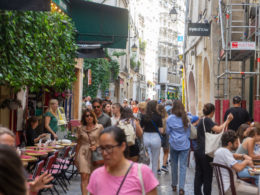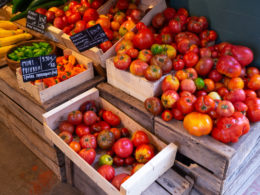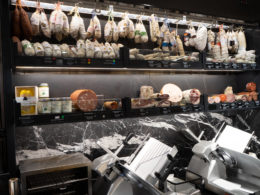If you’re coming to Paris for the first time then this guide is for you. I’ve put together everything you need to know about visiting this incredible city and comes from my experience living here for over 8 years.
From tips on navigating French culture, how to get around and what to see, bookmark this to help you enjoy your first trip to Paris!

This guide is split into the following sections:
What to Expect When Visiting Paris for the First Time
Paris is one of those cities that people either love or hate. On social media it’s got a reputation for being overrated although I genuinely struggle to see why. Even though I’ve been living here for 8 years, the city and main sights still blow me away.
Many people visit expecting an idyllic, romantic, pristine city and find that it’s far from reality. There’s even an official medical diagnose for this disappointment – Paris syndrome.

It’s important to manage expectations when visiting. It’s a real city where real people live and work. Paris is densely populated, loud and the weather is not always great. You may find trash on the streets (although I genuinely don’t find it particularly dirty) and yes, there will be some grumpy Parisians. It’s really just like any other capital city.
That said I think it’s one of the most beautiful and enchanting cities in Europe and if you come prepared, I think you’ll have an amazing time.
Here’s what I think you need to learn before you come to Paris and to ensure that you have a great trip!
Paris’ Neighbourhoods
Paris is split into 20 different arrondissements or areas. These arrondissements spiral outward from the city centre (the 1st being in the very city centre) in a clockwise direction (almost as if they form a snail). An arrondissement doesn’t confine specific neighbourhoods – for example the Marais straddles both the 3rd and the 4th arrondissement.
The city is cut in half by the River Seine with the bottom half being referred to as the left bank (in reference to the direct of the flow of water). It’s here where you’ll find the Latin Quarter and the Saint Germain des Prés districts.
The top is the right bank and is home to the Montmartre and Marais neighbourhoods of the city.
How to Get Around
Getting around Paris is easy thanks to its relatively small size and its excellent public transport options.
Metro & RER
The easiest and quickest way to get around Paris is by taking the Metro. First built in 1900, it consists of 14 lines, each identified by numbers (Line 1, 3 etc) and distinct colors, covering over 200 kilometres of track. It has more than 300 stations, making it one of the densest in the world.

There’s also the RER system which are more overland trains that connect Paris to the suburbs. These lines are identified with letters (RER A, RER B etc).
Here’s what else you should know about the metro and RER system in Paris:
- The fares work in a zonal system (similar to London). Zones 1-3 cover central Paris and 4-5 go outwards the suburbs and beyond and include Versailles and Disneyland.
- You can now buy tickets on your phone from the Bonjour RATP app.
- Paper tickets can be bought from multi-lingual ticket machines in all of the city’s stations. One ticket = 1 ride.
- You must keep your ticket as ticket inspectors frequently patrol the city’s stations. Only bin them after you’ve left the station.
- The metro runs from 5:30am to 12:30am (first and last departure from either end of the line). On Friday and Saturday nights the last metro leaves at 1:30am.
Taxi
If you’re wanting to take a taxi around the city then I’d recommend Uber. It’s the cheapest although in recent years its become more difficult to find a driver. There’s also Bolt and Heetch that are similar ride sharing apps that operate in Paris.
There’s also conventional taxi companies with the most popular being G7 and Alpha.

These tend to be more expensive than services like Uber as they run by the meter. That said if you’re travelling from either Charles de Gaulle Airport or Orly Airport there are fixed fees depending on which part of Paris you’re travelling to:
- Right Bank of Paris to Charles-de-Gaulle Airport: €56
- Left Bank of Paris to Charles-de-Gaulle Airport: €65
- Right Bank of Paris to Orly Airport: €44
- Left Bank of Paris to Orly Airport: €36
Cycling
Getting around by bike in Paris has become increasingly popular, thanks to the city’s very recent investment in cycling infrastructure and cycle lanes.
Vélib‘, the city’s public bike-sharing system, offers over 20,000 bikes, including electric options, available at over 1400 stations across Paris.
- The price is dependant on usage and increases every 30 minutes.
- If you buy a 24hr pass, the first 30 minutes are free.
- Bikes are frequently broken (flat tire, dodgy brakes etc). Check them before you peddle off!
Language & Culture
The official language in France and Paris is French. Don’t worry if you don’t speak the language, English is spoken throughout the city.
That said, learning some of the key phrases is a must and it will be appreciated. One of the most important phrases that you must learn before you visit is Bonjour (the formal Hello or Good Day).
Saying ‘Bonjour’ when you enter a store, restaurant or bar is a MUST. This simple phrase is a show of respect and it goes a long way. I’ve seen many tourist not say it or reply back when greeted and then be ignored. It’s a key part of daily interactions here.
Here’s also some key things to understand about French and Parisian culture:
- Money, status or attitude doesn’t change how you are treated here. People don’t ask to ’speak to the manager’ here and throwing money around won’t help you get a reservation.
- Customer service isn’t like it is in the US or UK and you’ll have to deal with it. You won’t get a discount off your bill if they forget something on your order. Store staff are busy chatting? You’ll have to wait for them to finish.
Weather
The weather in Paris varies across the year, with all 4 seasons bringing a distinctive feel to the capital.
Spring (March to May) brings milder weather, with temperatures rising to 10°C to 17°C (50°F to 63°F). It’s one of my favorite times of the year as the trees regain their green leaves and the terraces come alive again.
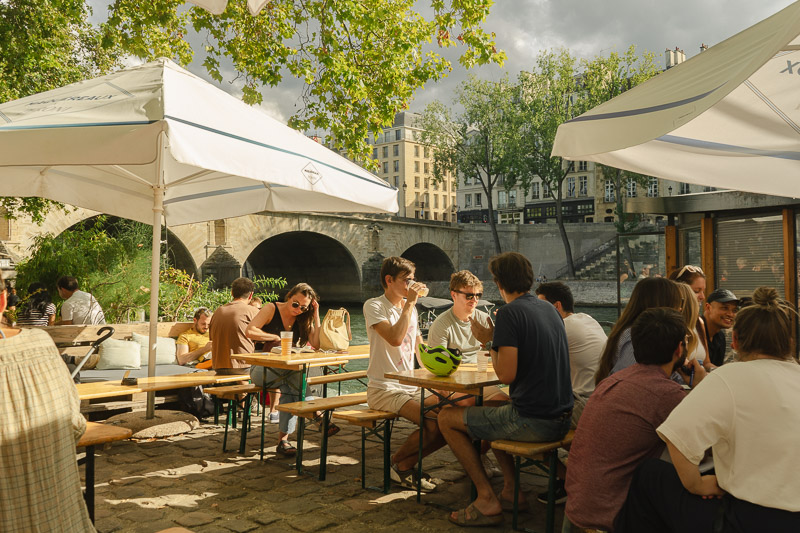
Summers (June to August) are warm, with temperatures between 17°C and 30°C (63°F to 86°F). Heatwaves are common in July and August and temperatures can go beyond 35c/95f. Fall (September to November) is cooler, with crisp air and temperatures around 10°C to 15°C (50°F to 59°F).
Winters (December to February) are cold, with average temperatures ranging from 3°C to 7°C (37°F to 45°F). In my experience it’s common to experience a few days of light snow.
Food in Paris
Food in Paris is generally very good BUT just like in any other capital city, there is going to be bad restaurants! I hear a lot of people saying that French food is overrated but again, like any other cuisine, it can be done well and it can be done badly.

If you do your research and reserve well in advance, you’ll eat extremely well. Check out my guides to the best restaurants in Paris and the best bistros in Paris for traditional French food.
Advice When Eating Out
Eating out in France is very different to the USA & UK. In fact the whole approach to hospitality is almost inverted.
In France, the approach is simple: you’re in their house and you need to follow their rules. The customer isn’t always right in France!

If you want to learn more, I’ve written a separate guide on eating out and tipping culture in Paris. Here are some of the highlights:
- Customization of menu items is generally isn’t a thing (the chef knows best!). Take bacon out of a boeuf bourguignon – not going to happen. That said, it’s usually fine to ask for a change of sides in most large restaurants. Want mashed potato or salad instead of fries? No worries – I do it all the time!
- There’s no need to tip in Paris. Service is always included in the bill and servers receive a good salary in France.
- You need to ask for the check/bill (l’addition) – they won’t bring it to you automatically. The French take their time eating out and you won’t be rushed!
- Parisians typically eat at 7pm (earliest) but more commonly around 8pm. You won’t find a restaurant booking at 5pm.
- Some restaurants (usually terrasses and cafés) serve food non-stop throughout the day – the phrase to look out for here is service continu.
Museum and Attraction Passes
Regardless of the time of the year you come to Paris, there will always be crowds. Speaking of, if you’re deciding on when to come, check out my guide to the best time to visit Paris.

Wether you’re visiting the Eiffel Tower, the Arc de Triomphe or the Louvre, you’re going to be waiting with a lot of other tourists to buy tickets.
I’d recommend booking a museum pass in advance (note the Eiffel Tower is not included). You can buy them here. This pass allows access into over 50 museums, galleries and monuments in central Paris. It allows you to skip the queues for the ticket office (not security) and get straight in!
If you want to book a timed Eiffel Tower slot you can get this here.
Practical Advice
- Ensure that you bring an EU power adapter – electrical outlets are not the same than in the US and the UK.
- Most stores and restaurants accept Visa and Mastercard. You’ll only find market stands, some bars and a few restaurants that only accept cash.
- AMEX isn’t accepted everywhere. Check their website to see which shops, restaurants and bars accept it.
What You Need to See During Your First Trip
Wondering what to see during your first trip to Paris? Here’s my recommendations on are the must visits and do’s.
Explore the Louvre
The Louvre is the most famous and has the most extensive collection of any museum in the world. It’s incredible and definitely worth a visit. Saying it’s big is an understatement – it would take days to see every exhibit in the museum.
That said you can easily see the main pieces (the Mona Lisa, Venus de Milo etc) in a few hours.


If you’re running low on time and don’t want to visit the actual museum you can, once you pass initial security, go into the main atrium. Here you can see the famous glass pyramid from inside.
I’d also recommend you also walk around the Louvre outside – especially through the Jardin des Tuileries.
Want to learn more about visiting the museum? Check out my guide to visiting the Louvre.
Visit Montmartre
The old village of Montmartre is another must-visit area of Paris. Amélie Poulain’s playground and home to the magnificent Sacre-Cœur Basilica, its beautifully old Parisian.
You can spend about a day exploring the neighbourhood and seeing the sights. Check out my guide on what to do and see in Montmartre for more information.

Good to know: Montmartre is hilly and is one of the highest points in Paris. Expect to walk up a lot of stairs to reach the top of the village.
It’s also a great area to have dinner or lunch – check out my guide to the best restaurants in Montmartre for foodie recommendations.
See the Eiffel Tower
The Eiffel Tower is perhaps the most recognisable monument in Paris. Even after living here for over 8 years I still find it incredibly impressive.
For me, you’ve got to see the Eiffel Tower but is it worth climbing up it? Well it’s said that the best view of Paris is one with the Eiffel Tower.

It’s true that it gives spectacular views across the city and beyond but i’ll admit, the views do miss the Eiffel Tower itself!
That said, it’s definitely worth doing if you have the time to see the structure and take in the views. I’d strongly recommend paying extra to take the lift rather than walking up the stairs (trust me, it’s exhausting!).
If you haven’t got time to climb up the tower, I’d advise walking around the Champ de Mars and around the gardens and then heading over to Trocadero to get one of the best views of the Eiffel Tower.
Eat in a Traditional French Bistro
France is famous for its food and there’s no better place to sample some of the country’s cuisine than in a cosy Parisian bistro.
In the summer months most of the city’s bistros have outdoor terraces which are great spots to eat and watch the world go by. In the colder months you’ll be inside and experience the get atmosphere of an authentic bistro.

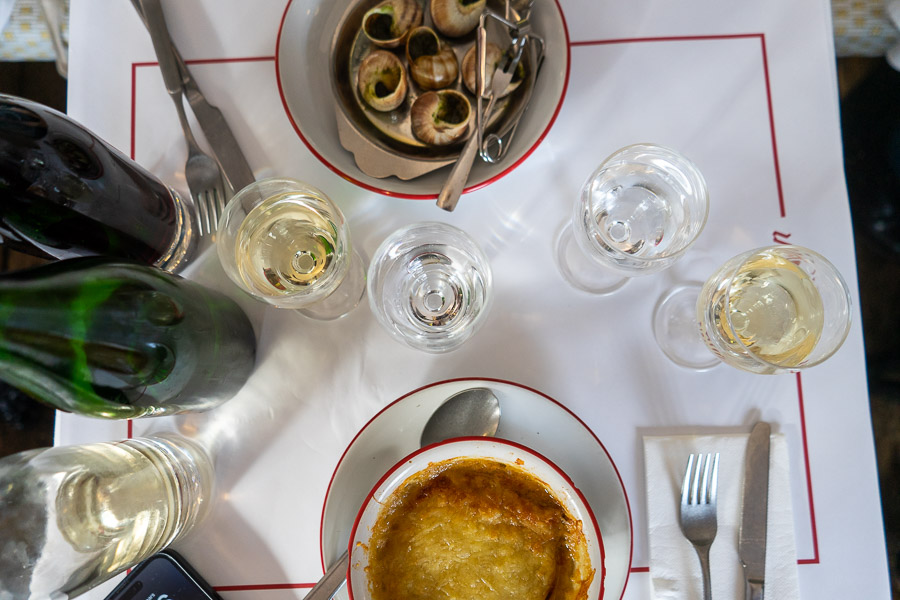
French onion soup, steak frites and snails cooked in garlic butter – there’s a lot of great French dishes that you need to try.
Wondering what are the best French bistros in Paris to try? Check out my guide here.
Explore the City’s Parks
Paris is home to some absolutely stunning parks. They’re perfect if you want to take a break away from the manic city streets, enjoy some greenery and have a picnic.
During fall the leaves turn a beautiful golden brown and the parks becomes very picteresque. My favorites are the Jardin du Luxembourg and the Buttechaumont park in the 20th arrondissement.
Discover more about the city’s incredible parks in my guide here.
Spend a Day in Le Marais
Le Marais is a beautiful medieval neighbourhood in the very city centre. It’s famous for being the city’s Jewish and gay district as well as being great for shopping!
Steeped in history, it’s worth spending a day checking out the Place des Vosges, wondering the old streets and eating some delicious falafel sandwiches.
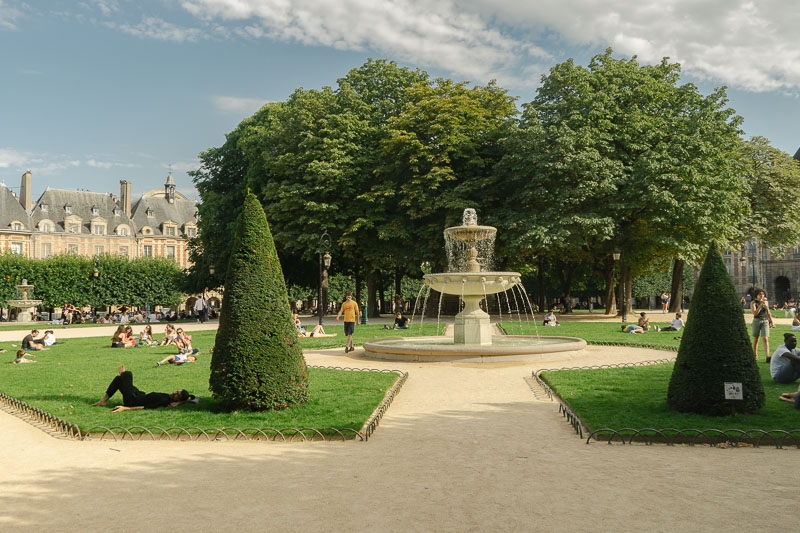
Check out my guide to Le Marais and also my recommendations on where to eat well in the area.









